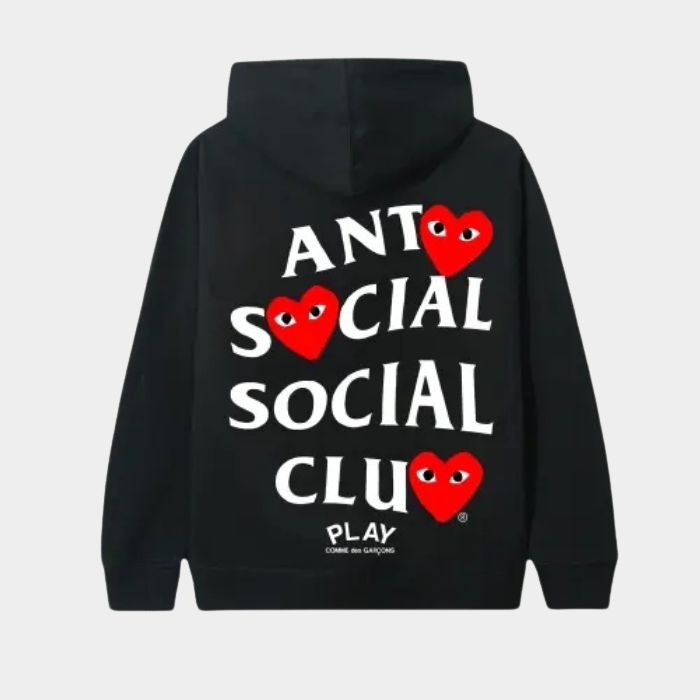Streetwear has always thrived on disruption, but Comme Des Garçons brought a different kind of rebellion. It wasn’t about oversized graphics or bold slogans. Instead, it was a quiet, intellectual dismantling of fashion’s very rules. For decades, the label has pushed boundaries in ways that seeped far beyond the runway, reshaping what people wear on sidewalks, in skate parks, and at underground clubs.
Rei Kawakubo’s Radical Vision
At the center of it all is Rei Kawakubo, the enigmatic founder who rarely explains her work, letting the garments speak in riddles and contradictions. From the start, she challenged the notion of beauty in clothing. Torn fabrics, asymmetry, and unconventional silhouettes became her vocabulary. In an era when polished perfection was the norm, she introduced imperfection as a new aesthetic. That mindset trickled down, showing younger generations that fashion doesn’t need to please—it can provoke.
Deconstruction as Style, Not Mistake
What once looked like unfinished garments became a deliberate statement. Comme Des Garçons pioneered the idea that seams could be exposed, hems could be uneven, and garments could look almost broken yet intentional. This raw deconstruction influenced countless streetwear designers who began ripping apart traditional structures to create something fresh. In skate culture and hip-hop communities, that imperfect look found a natural home. Clothing no longer had to be pristine. It had to feel alive.
Bridging the Gap Between Avant-Garde and Everyday
Streetwear is built on accessibility, while avant-garde fashion often feels distant and untouchable. Comme Des Garçons blurred that divide. The brand proved that intellectual, boundary-pushing design could exist alongside the everyday hoodie or sneaker. Kawakubo’s work gave legitimacy to experimental clothing within streetwear circles, inspiring wearers to embrace individuality without abandoning comfort or utility.
Collaborations That Reshaped Streetwear Culture
Part of Comme Des Garçons’ genius lies in its collaborations. The brand linked arms with Nike, Supreme, Converse, and countless others, fusing high-concept design with the raw energy of streetwear. These partnerships weren’t just about slapping logos together. They created hybrids—shoes, tees, and jackets that carried both prestige and street credibility. Suddenly, avant-garde wasn’t confined to galleries or couture runways. It was on the feet of kids lining up outside sneaker shops.
The Rise of Play: Minimalism Meets Mass Appeal
Comme Des Garçons Play, with its now-iconic heart logo, opened a new chapter. It offered something approachable without losing the DNA of the brand. Clean cuts, simple shapes, and that cheeky logo became staples in wardrobes worldwide. Play bridged the gap between exclusivity and accessibility, letting streetwear enthusiasts participate in the world of Comme without needing to decode the complexities of its runway shows.
Influence on Modern Streetwear Labels
Today, countless labels borrow from Kawakubo’s playbook. Brands like Off-White, A-COLD-WALL*, and Vetements lean heavily on deconstruction, irony, and conceptual storytelling. The DNA of Comme Des Garçons is visible in how designers challenge form and function, how they merge luxury with grit, and how they refuse to stick to the rules. Streetwear as we know it would look very different without those early provocations.
Redefining Gender Norms in Fashion
Another way Comme Des Garçons transformed streetwear is through its dismantling of gender norms. Long before unisex fashion became mainstream, Kawakubo blurred those lines. Oversized cuts, neutral tones, and ambiguous silhouettes freed clothing from the binary. This ethos resonated with streetwear, where individuality and defiance already ran deep. For Gen Z and millennials, the idea that clothing belongs to no gender feels almost natural—thanks, in part, to this groundwork.
Conclusion: A Legacy That Continues to Evolve
Comme Des Garçons didn’t just influence streetwear. It rewired it. By introducing imperfection, intellectual rebellion, and radical collaboration, the brand shifted the culture from the inside out. What began as avant-garde statements on the runway bled into the streets, shaping how people dress, express themselves, and challenge the norm. Streetwear will keep evolving, but the fingerprints of Comme Des Garçons will always be there, stitched into every disrupted seam and unconventional silhouette

